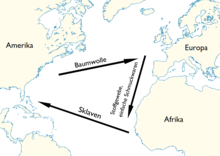Atlantic triangular trade
The term Atlantic triangular trade describes an explanatory model for the goods trade carried out across the Atlantic Ocean between Europe, Africa and America in the early modern period , which was also a special form of the general slave trade . The term is now considered out of date.
procedure
The triangular trade began at the end of the 17th century and ended at the beginning of the 19th century. Ideally, the model is based on three trading stations that form a closed chain:
From Europe (in October) the ships loaded with firearms , steel and bronze ingots, coarse cloth , glass beads and manufactured goods drove to the West African coast (coastline between today's Cameroon and Liberia ), where the goods were exchanged for slaves. The slaves were bought from local traders at slave markets.
Then (from around the beginning of December) the ships headed for the Caribbean, where agricultural products such as cane sugar, rum and molasses as well as cotton were purchased from the proceeds of the slaves .
From April, the ships sailed back to their home ports, mostly laden with sugar products, in order to sell the freight at a profit on the European market. The ships arrived home in early European summer.
The "trade winds", ocean currents and the westerly wind zone , which is also shifting, were used in a temporal adjustment to the seasonal shifting trade winds .
Trips in the triangular trade lasted (depending on the area) a total of over 500 days. The Leusden , a ship of the Dutch West India Company , can be mentioned as an example of the different journey times of the slave ships .
history
Portuguese, French, Dutch and English trading companies were involved in the trade , but above all the English Royal African Company , which sold slaves to the various colonies. The German Brandenburg-African Company, which was active at the end of the 17th century, was 0.15 to 0.2 percent involved in the roughly four-hundred-year triangular trade in slaves.
criticism
The term “triangular trade” is criticized today as inappropriate and not neutral. According to the journalist Nadja Ofuatey-Alazard, the term enslaved people is part of a recycling chain with goods and linguistically commodifies them. The procedural dimensions of slavery and its racist basis would also be obscured by this term. Scientists also state that actually only a small part of the European trips to Africa took place within the framework of the triangular trade. Between 1671 and 1807, 95 percent of the slightly more than 3,000 ships that went from Denmark, Norway and Schleswig-Holstein to the West Indies sailed directly to the Caribbean and back. Of the total of only 229 trips made up to the year 1754, 87 were still on the triangular route. Atlantic trade was by no means always in the form of a triangle: European ships, for example, bought slaves on the slave coast in order to sell them on the gold coast to African rulers and then return to Europe laden with gold. There were also direct trade relations between America and Africa. In addition, the term excludes the slave trade within Africa and escapes the process of slavery itself, which was also carried out by Africans: In the narrative of the triangular trade, these appear only as passive victims, but not also as perpetrators. The impression is also given as if individual European ships had sailed the entire triangle, which is very unlikely in view of the different construction methods of slave and normal merchant ships. Therefore, the educational scientist Roland Bernhard and the historian Jutta Wimmler propose “to consistently dispense with the term triangular trade”.
literature
- Christian Degn: The Schimmelmanns in the Atlantic triangular trade. Profit and conscience . 3rd unchanged edition, Wachholtz, Neumünster 2000, ISBN 3-529-06148-4 .
- Armin Fischer: The slave transporters. The triangle between Europe, Africa and America with sugar and slaves . In: Mare. Die Zeitschrift der Meere 1 (1997), ISSN 1432-928X , pp. 84-88.
French speaking
- Raymond-Marin Lemesle: Le commerce colonial triangulaire. (XVIIIe - XIXe siècles). Presses universitaires de France, Paris 1998, ISBN 2-13-049340-8 ( Que sais-je? 3393).
- Olivier Pétré-Grenouilleau: La traite des noirs . 2. édition corrige. Presses universitaires de France, Paris 1998, ISBN 2-13-048415-8 ( Que sais-je? 3248).
- Jean Meyer: Esclaves et Négriers . Gallimard-Découvertes, Paris 1998, ISBN 2-07-053018-3 ( Découvertes Gallimard. Histoire 11).
English speaking
- Hugh Thomas : The slave trade. The history of the Atlantic slave trade. 1440-1870 . Phoenix Books, London 2006, ISBN 0-7538-2056-0 .
Remarks
- ↑ In 1807 England ended the slave trade by prohibiting it. Slavery was still allowed, however, and was officially practiced in various American countries, until Brazil became the last American state to ban this in 1888 with the Lei Áurea .
Web links
Individual evidence
- ↑ See Andrea Weindl: The Kurbrandenburg in the "Atlantic System" (1650-1720) . In: Working papers on Latin American Studies, II. Iberian and Latin American History , II-03 PDF , p. 67.
- ↑ Nadja Ofuatey-Alazard: The European enslavement of African people . In: the same and Susan Arndt (ed.): How racism speaks out of words. (K) Heirs of colonialism in the knowledge archive of the German language. A critical reference work . Unrast Verlag, Münster 2015, p. 112.
- ↑ Dieter Lohmeier: Slaves - Sugar - Rum. Denmark and Schleswig-Holstein in the Atlantic triangular trade. Exhibition by the Schleswig-Holstein State Library from February 20 to April 10, 1994 (= publications of the Schleswig-Holstein State Library, Vol. 18), Heide / Holstein 1994.
- ^ Roland Bernhard and Jutta Wimmler: “Dreieckshandel”, Glasperlen und Gender. Mythical narratives on the transatlantic slave trade in current German and Austrian school books. In: History in Science and Education 70, Issue 3/4 (2019), pp. 149–164, the quotation p. 163.

